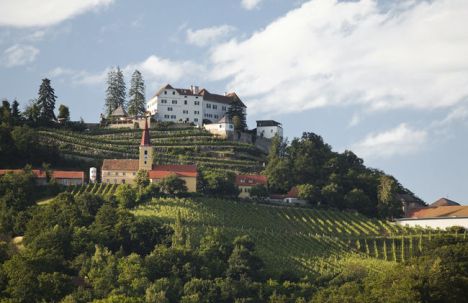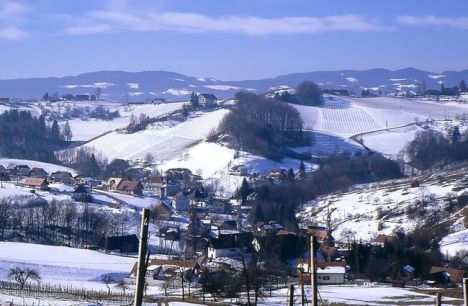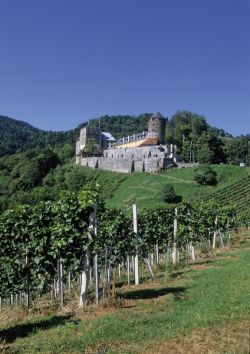The importance of Styria in the wine world can hardly be overestimated today. Some of the best Sauvignons and Burgundies to be found anywhere come from here, as do Muskateller and Gewürztraminer. Even the basic wines of the best wineries would be flagships on many other estates. At the top, Styria is not only hard to beat in terms of quality: although we are dealing with internationally widespread grape varieties, the wines in Styria almost always have a completely unique character. This is true for the whole region - Styria is recognisable as a whole - but it is also true for the individual winegrowers, regions and sites. If you are looking for a drinkable, but not unpretentious everyday wine, Styria is the place to be; if you are looking for great, independent, world-class white wines that can be stored for decades, this is the region for you.
 |
| Vineyards at the foot of Kapfenstein Castle in south-eastern Styria (Source: ÖWM / Anna Stöcher) |
The Austrian province of Styria is located in the south-east of the country and borders Upper and Lower Austria to the north, Burgenland to the east, Salzburg to the west and Carinthia to the south-west. The wine-growing region, which is identical in area to the federal state, is called Steirerland and is divided into the three wine-growing regions of Western Styria, Southern Styria and South-Eastern Styria. All three are located in the south of the region on the border with Slovenia and stretch from west to east between Carinthia and Burgenland.
With around 4,200 hectares of vineyards, Steirerland is the second smallest Austrian wine-growing region after Vienna. The vineyards are located at an altitude of up to 700 metres, mostly on steep slopes. The main grape variety is Welschriesling, followed by Pinot Blanc and Sauvignon Blanc. In addition, Chardonnay (which is called Morillon here), Müller-Thurgau (Rivaner), Muskateller and Scheurebe (Sämling 88) as well as Traminer, Grauburgunder (Ruländer) and Riesling are grown as white varieties. The main red varieties are Blauer Wildbacher and Zweigelt, the former being cultivated mainly in western Styria for the rosé wine speciality Schilcher.
Vinorama, Austria's largest mail-order wine company, has prepared a package of representative single vineyards from Styria for Wein-Plus readers. There is such a selection for each theme in the section "Austria in Focus", so that you can easily get your own impression of the wines from the respective region presented. All you have to do is register once at Vinorama for the sample package; you will then receive it automatically with each new theme until further notice - free of shipping costs!
Find out more and order the Vinorama package directly here
With a good 2,300 hectares, Southern Styria accounts for more than half of Styria's vineyard area. The range of varieties is correspondingly large, with Sauvignon Blanc, Welschriesling, Muskateller, Chardonnay (Morillon), Pinot Blanc, Müller-Thurgau and Traminer as well as Zweigelt as the most important grapes. The vines are often planted on extreme steep slopes on slate, sand, marl, primary rock and limestone; this soil type is also known as Opok. The warm, humid Mediterranean climate allows for a long vegetation cycle and, with cool nights, ensures that the wines are richly nuanced in aroma.
The steepest vineyards are in the Sausal, whose main town, Kitzeck, is also the highest wine-growing community in Austria. Other important wine villages in the Südsteirisches Weinland are Berghausen, Ehrenhausen, Eichberg-Trautenburg, Gamlitz, Glanz, Ratsch, Spielfeld and Sulztal. Outstanding wines come, for example, from the single vineyard sites Czamillonberg, Grassnitzberg, Kittenberg, Nussberg, Obegg, Sernauberg, Kranachberg and Zieregg.
 |
| Winter landscape in South Styria (Source: ÖWM / Armin Faber) |
Southeast Styria has 1,400 hectares of vineyards scattered throughout the region in numerous small islands. Here, too, there is a great diversity of varieties with Welschriesling, Traminer, Morillon, Pinot Blanc and Pinot Gris, Muscat, Sauvignon Blanc and Riesling as well as Zweigelt. The soils consist mainly of volcanic soil, basalt, sand, clay and weathered rock. In the transition zone between hot, dry (Pannonian) and warm, humid Mediterranean climate, there are large temperature differences between day and night, which in turn promotes the aromatic qualities of the wines. The wines owe their fine mineral flavour to the volcanic rock.
The most important wine-growing communities in south-eastern Styria include Bad Radkersburg, Feldbach, Gleisdorf, Hartberg, Kapfenstein, Klöch, Riegersburg, St. Peter, Straden, Tieschen, Weiz as well as Bad Gleichenberg, Fürstenfeld and St. Anna am Aigen. On the Ringkogel in the north of the region, the vineyards lie at up to 650 metres above sea level.
With around 500 hectares of vineyards, Western Styria is Styria's smallest wine-growing region. More than 80 percent of the grapes grown here are Blauer Wildbacher, with some Weißburgunder (Pinot Blanc) and Chardonnay. The Blauer Wildbacher is used to make Schilcher, a rosé wine characterised by an onion-coloured colour and a striking acidity; however, there are also strong red and even sweet varieties. The vines are rooted in gneiss, slate and sedimentary rock, mainly marl. The Illyrian climate is characterised by warm Mediterranean influences and relatively high rainfall.
The vineyards, which run north-south in a narrow band at an altitude of up to 600 metres, warm up strongly during the day and are protected from harsh winds. The most important wine-growing villages are Deutschlandsberg, Stainz and St. Stefan ob Stainz, as well as Greisdorf, Gundersdorf, Wildbach and Wies.
 |
| Deutschlandsberg Castle in Western Styria (Source: ÖWM / Armin Faber) |
The interest group "Steirische Terroir- und Klassikweingüter" (STK) has developed its own site classification. This winegrowers' association emerged from the group "Steirische Klassik-Winzer" (Styrian Classic Winegrowers), founded in 1986, which - as it says on the website stk-wein.at - "from 1993 onwards coined and successfully spread the term 'Steirische Klassik' (Styrian Classic) for fresh and fruity white wines made from typical Styrian grape varieties". Today, the wineries Gross, Lackner-Tinnacher, Wolfgang Maitz, Neumeister, Erich & Walter Polz, Erwin Sabathi, Hannes Sabathi, Sattlerhof, Tement and Winkler-Hermaden belong to the association.
The STK wineries have defined four categories for their wines: "Welschriesling STK", "Steirische Klassik STK" as well as "Erste STK Lage" and "Große STK Lage". For each of these categories, specific criteria have been defined, which the member wineries have contractually committed to uphold. These criteria concern, among other things, the exact origin of the grapes, the grape varieties, the harvest quantity, the ageing, the ripening potential and the earliest marketing date.
The STK quality seal is a protected trademark for the growths of the winegrowers' association. The corresponding wines bear the mark on a banderole, on the label or as a capsule imprint - in different colours depending on the category (in gold for single vineyards ).
All currently tasted Styrian white wines
All Styrian Sauvignon Blanc wines currently tasted
All Styrian Morillon (Chardonnay) currently tasted
All Styrian Muskateller currently tasted
All Styrian Pinot Blancs currently tasted
All Styrian Pinot Gris currently tasted
All Styrian Traminer and Gewürztraminer currently tasted
All Styrian Riesling currently tasted
All Styrian Welschriesling currently tasted